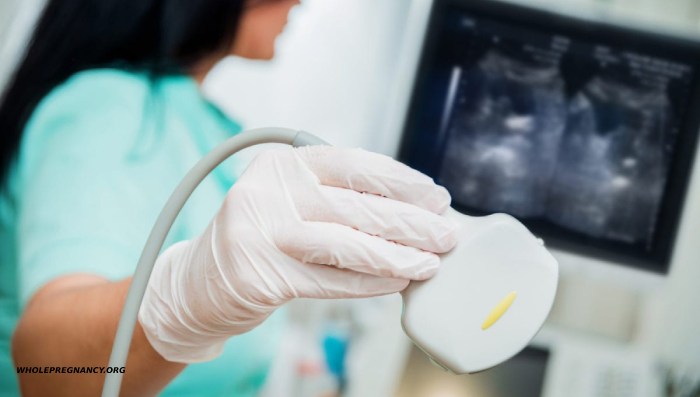What is a pelvic ultrasound?

What is a pelvic ultrasound?
A pelvic ultrasound, is a non-invasive diagnostic exam, produces images that can be used to evaluate organs and structures in the female pelvis. A pelvic ultrasound is a quick way to visualize the female pelvic organs, structures, and vaginal structures, including the uterus and cervix. Ultrasound uses a transducer to send out waves at a frequency that is too high for people to hear.
The ultrasound transducer is applied to the skin and the sound waves travel through the body to the structures and organs. The sound waves bounce off organs as an echo, and then return to the transducer. The reflected waves are processed by the transducer, and then converted into images of the tissues or organs being examined. The speed at which sound waves travel depends on the tissue they are passing through. For example, bone tissue is faster than air tissue.
Transducers translate different types of tissue by translating the speed at which sound waves are sent back to them and how much. To ensure the smoothest sound conduction, an ultrasound gel is applied to the transducer and skin. Doppler ultrasound (sometimes called a duplex exam) is another type of ultrasound. It shows the direction and speed of blood flow through certain pelvic organs. Doppler ultrasound is audible, unlike a standard ultrasound. One or both of the following methods can be used to perform a pelvic ultrasound:
- Transabdominal (through your abdomen). The conductive gel is used to place a transducer on the abdomen.
- Transvaginal (through your vagina). Insert the transducer into the vagina.
The reason for the ultrasound will determine the type of procedure. One method can be used or both. Another procedure that can be used to assess pelvic problems are hysteroscopy and colposcopy.
What are the pelvic organs of a female?
The organs and structures that make up the female pelvis are:
- Endometrium. The lining of your uterus
- Uterus, also known as the womb. The uterus, a hollow, pear-shaped organ, is located between the bladder and the rectum in the lower abdomen of a woman. Unless an ovum is implanted, the uterus sheds its lining every month. Then pregnancy occurs.
- Ovaries. The pelvis contains two female reproductive organs. They are responsible for the development and storage of egg cells (ova). Also, they are where estrogen and progesterone are made.
- Cervix. This is the lower, narrower part of the uterus, located between the bladder rectum and the bladder. It forms a canal that opens into a vagina which leads to the exterior of the body.
- Vagina also known by the birth canal, this is the passageway through which fluid flows out of the body during menstrual cycles. The vagina is the connection between the cervix (external genitalia) and the vulva.
- Vulva. Vulva is the external part of the female genital organs
What are the reasons to have a pelvic ultrasound performed?
The evaluation and measurement of the female pelvic organs can be done using a pelvic ultrasound. The following are some examples of ultrasound evaluations of the pelvis:
- The size, shape and location of the uterus, ovaries, and testicles
- Thickness, echogenicity (darkness/lightness of the image due to the density or tissue), presence of fluids or mass in the endometrium or myometrium (uterine muscles tissue), fallopian tubes or in or near bladder
- The cervix’s length and thickness
- Modifications in the shape of the bladder
- Blood flow through the pelvic organs
Although a pelvic ultrasound can give information about the location and size of pelvic mass, it cannot diagnose cancer or a specific disease. The following conditions can be diagnosed and treated with a pelvic ultrasound:
- Abnormalities in the anatomy of the uterus, which includes endometrial conditions
- Fibroid Tumors (benign growths), cysts, masses, cysts and other types within the pelvis
- Position and presence of an intrauterine contraceptive (IUD),
- Pelvic inflammation disease (PID), and other types of inflammation/infection
- Bleeding after menopause
- For infertility evaluation, monitor the size of the ovarian follicles
- In vitro Fertilization: Aspiration of Follicle Fluid and Eggs from Ovaries
- Ectopic pregnancy (pregnancy that occurs outside the uterus, often in the fallopian tube).
- Monitoring fetal development during pregnancy
- Certain fetal conditions can be assessed
Other procedures, such as endometrial biopsies, may also benefit from ultrasound. Sonohysterography is a procedure where the fluid inside the uterus is drained to enable better imaging. Your doctor may recommend a pelvic ultrasound for other reasons.
What are the potential risks associated with a pelvic ultrasound procedure?
The transabdominal ultrasound uses no radiation and causes no discomfort. The transvaginal transducer may cause slight discomfort. Patients with latex allergies may react to transvaginal ultrasound by covering the ultrasound transducer with a plastic or latex sheath.
Transabdominal ultrasounds can cause discomfort if you have a full bladder, or lie on the exam table. A urinary catheter can be used to fill the bladder if a transabdominal ultrasound is required quickly. Your specific medical condition may pose risks. Before you undergo the procedure, discuss your concerns with your doctor. The results of the test may be affected by certain factors and conditions. The following are some examples:
- Severe obesity
- A recent barium procedure left barium in the intestines
- Intestinal gas
- Transabdominal ultrasound shows that a full bladder can cause inadequacy. Full bladder allows for the movement of the uterus and bowel, which in turn helps to improve imaging.
How can I prepare for a pelvic ultrasound?
DRINK: At least 24 ounces of fluid should be consumed at least an hour before the appointment. After the exam, do not empty your bladder. A pelvic ultrasound does not require any fasting or sedation, except when it is part of anesthesia-related procedure. Before you have a transvaginal ultrasound, empty your bladder. Your doctor will explain everything to you, and give you the chance to ask any questions about the procedure. Also he may recommend a different preparation depending on your medical condition.
What happens during a pelvic ultrasonography?
An ultrasound of the pelvis can be done in your doctor’s office or on an outpatient basis. The procedure may differ depending on your situation and the hospital’s policies. A pelvic ultrasound is usually performed after this procedure.
- The computer screen will display images of structures. Images of structures will be displayed on the computer screen.
- After the procedure is completed, the gel can be removed.
- After the procedure is complete, you may need to empty your bladder.
Transvaginal ultrasound
- The scan will require you to take off any jewelry or clothing that could interfere with the process.
- If you are asked to take off your clothing, you will receive a gown.
- As part of a pelvic exam, you will be required to lie down on an examination table with your legs and feet supported.
- The transvaginal transducer is a long and thin piece of transvaginal ultrasound equipment. It will be covered in a plastic or latex sheath, and lubricated. The transducer’s tip will be inserted into the vagina. This can be slightly uncomfortable.
- To bring focus to the study areas, the transducer is gently turned and angled. As the transducer moves, you may feel some pressure.
- When the Doppler probe’s blood flow is being measured, you might hear a “whoosh,” whoosh sound.
- The computer screen will display images of organs and other structures. Images can be recorded on different media to support the health record.
- After the procedure is completed, the transducer can be removed.
What Happens After a Pelvic Ultrasound After a pelvic ultrasound, there is no need for special care. Unless your doctor tells you otherwise, you can resume your normal activities and diet. Exposure to ultrasound at the levels used in diagnostic ultrasound is not known to cause any adverse biological effects for patients or operators. Your individual situation may require additional or alternate instructions from your doctor.




